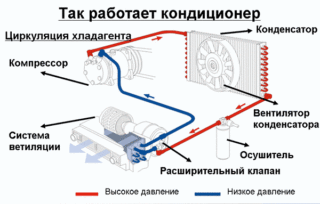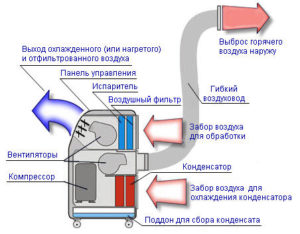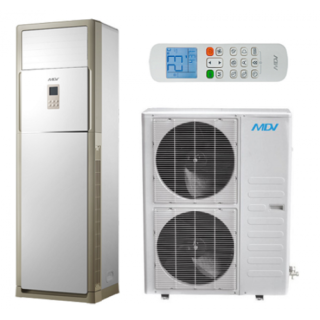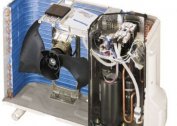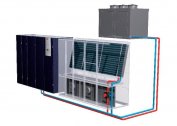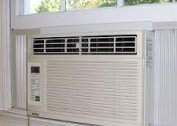Air conditioning (from Lat. Сondicio - condition, condition) is a process in which in an automatic mode in the production shops, car dealerships, residential buildings, etc., air parameters are created and maintained that are comfortable for people’s work and leisure, furniture safety, household appliances, cultural property, etc.
The term “air conditioning” was first introduced by Stuart Kremer (USA), using it in 1906 when drawing up a patent application for a device that provides increased humidity in rooms. The first electric air conditioner was invented 4 years before the American engineer Willis Haviland Carrier.
Types and characteristics of air conditioners
The main task of any air conditioner is air cooling. The process in all models is provided as follows: heated air masses pass through a tubular evaporator, the refrigerant circulating through its tubes takes heat from the air. The main role in the cooling process is played by the compressor.
For more than 100 years, enterprises have constantly invested material and financial resources in the design, manufacture and development of climate technology. The market has a large selection of air conditioners that use the same method of air cooling, but differ from each other in the control system, design, etc. All of them are classified according to the following criteria:
- application area;
- compressor control method;
- additional functionality.
Compressor control methods
All types of air conditioners are divided into two main groups - inverter and non-inverter.
Non-inverter air conditioners are devices that maintain a given air temperature by alternately turning the compressor on and off. This management method has been widely used in past years. It is notable for the complexity of adjustment and allows for air temperature differences. The main advantage of such air conditioners is their low cost. Among the shortcomings, consumers note high power consumption and noise during the operation of the product.
 Inverter air conditioners operate using the principle of converting alternating current to direct current with subsequent conversion to alternating current, but with the necessary frequency. At the same time, due to the change in frequency, it is possible to smoothly control the rotation speed (power) of the compressor motor, this allows you to change performance depending on air temperature. In the process, there is no need to regularly turn off and on the compressor, which is guaranteed to reduce energy consumption by about 20% and increase the life of the air conditioner. Among the advantages of inverter air conditioners are noiselessness, high accuracy of regulation and the absence of air temperature drops.
Inverter air conditioners operate using the principle of converting alternating current to direct current with subsequent conversion to alternating current, but with the necessary frequency. At the same time, due to the change in frequency, it is possible to smoothly control the rotation speed (power) of the compressor motor, this allows you to change performance depending on air temperature. In the process, there is no need to regularly turn off and on the compressor, which is guaranteed to reduce energy consumption by about 20% and increase the life of the air conditioner. Among the advantages of inverter air conditioners are noiselessness, high accuracy of regulation and the absence of air temperature drops.
During power surges, a malfunction may occur in the operation of electronic systems that control the operation of the device - this is one of the main disadvantages of the inverter.
Intended classification
In accordance with their purpose, air conditioners are:
- industrial (Unitary);
- commercial or semi-industrial (PAC - Packages air conditions);
- for home use or household (RAC - Room air conditions).
Household air conditioners
All types of air conditioners for an apartment have a power of 1.5 to 8 kW. Products of this class are distinguished by their attractive appearance and low noise level. Install them in rooms with an area of not more than 100 square meters. m. The service life of domestic air conditioners is from 7 to 10 years.
Household air conditioners and air conditioning systems are presented on the market in several design options according to the type of installation:
- Window - budget monoblock models with a capacity of up to 6 kW. Mounted in a window opening: the main part of the housing with a compressor protrudes onto the street, and inside the room there is only a control panel.
- Floor-mounted are mobile monoblocks that can be easily moved from room to room and connected without inviting specialists. To do this, it is only necessary to bring a flexible one and a half-meter hose through which the warm air will be removed from the room through a window or a hole in the wall. Simple installation is particularly attractive to consumers, but the proliferation of such devices is constrained by their high cost. Among the shortcomings, a fairly strong noise level and low power (up to 3 kW) can be noted. If you need to increase the power of the outdoor air conditioner, you can attach an additional outdoor unit with a fan to it.
- Wall - Split and multisplit systems belong to this type of conditioners. The first of them is a construction consisting of two blocks: a small internal and massive external, in which are very noisy components. The second system is a combination of one outdoor unit and several indoor units installed in different rooms. In this case, the internal mounted units can be made both in the ceiling, and in the wall or column version.
Air conditioners for industrial use
Industrial air conditioners are sophisticated air conditioning systems with a capacity of over 25 kW, in which the first place is to ensure a comfortable microclimate at industrial facilities (workshops, galvanic and paint sections). Using these systems, you can set a specific temperature in each room. To do this, use:
- multizone systems like VRF or VRV - allow you to adjust the air temperature with an accuracy of 0.5 ° C;
- central air conditioning systems;
- “chiller-fan coil” systems - provide not only air conditioning, but also its heating in each individual room.
Commercial air conditioners
Commercial air conditioning systems are air conditioning systems available on the market with devices:
- channel structures:
- cassette type;
- with ceiling mount;
- looking like columns.
The air conditioners, constructed in the form of columns, are equipped with powerful centrifugal fans that supply an air stream from 5 to 12 m long to the room. They have an attractive appearance and do not spoil the interior of a shopping or entertainment venue. They are used, as a rule, for air cooling in large exhibition pavilions, halls of restaurants, etc.
Ducted air conditioning systems are structurally a two-unit system. Usually their power does not exceed 25 kW. In this case, the indoor units are installed in the subceiling space of the premises and are connected together by a network of ducts. After installation is complete, the entire structure is closed with a false ceiling. The outdoor unit can be installed on the wall of the building in any convenient place.
Channel-type systems are used in cases where it is necessary to hide climatic equipment from prying eyes. With it, you can serve one or more rooms.
Climatic climatic equipment is a type of ducted air conditioner. Its internal blocks (cassettes) are closed with a decorative grille with distribution blinds. The grill has the size of a ceiling tile and fits well into the interior of any room.They are installed in the trading floors of large shops and other rooms where it is necessary to ensure the distribution of chilled air in 4 different directions.
Ceiling air conditioners with a capacity of up to 15 kW are installed in large rooms, where for one reason or another there is no suspended ceiling. They differ from other types of commercial climatic equipment in that they distribute air only along the ceiling. At the same time, the cooled air flow does not affect people in the room.
Functionality of air conditioners
In addition to its main purpose related to air cooling, many modern air conditioners are equipped with additional options that significantly expand their functionality:
- heating of air entering the premises from the street in the cold season;
- filtration of outside air and being in the room;
- drainage and disinfection of air;
- hydration, ionization.
 Air conditioners providing air purification are equipped with various types of filters:
Air conditioners providing air purification are equipped with various types of filters:
- antibacterial - purify the air of allergens and inhibit the growth of bacteria;
- Plasma - carry out deep air filtration, destroying mold, viruses and bacteria;
- deodorizing - purify the air from pungent odors of cosmetics and perfumes, tobacco smoke, etc .;
- universal - equipped with multi-stage filters.
Significantly improves air quality, the presence of the "Ionization" function in devices. Air saturated with negatively charged ions becomes fresh and invigorating, which has a beneficial effect on the work of the respiratory system.
Air conditioners with heating function
Air conditioners with the function of heating the air are the most popular type of climatic equipment on the domestic market. Models of this category function effectively in the “cold-heat” mode, provided that the air temperature outside the window is not lower than -10 ° C. At lower temperatures, air conditioners turn off or fail.
However, there are air conditioning systems that can operate at low temperatures of the order of -35 ° C. These are chiller-fancoil systems in which non-freezing liquids are used as a heat carrier. Such devices can be equipped with an additional gas boiler, which in winter works instead of a chiller, and, if necessary, with electric heaters built into each fan coil. They provide full heating and air conditioning in the premises, however, the cost of such systems compared to conventional air conditioners is much higher. Therefore, they are installed in shopping malls, office buildings and hotels.
